Persian Complete Shahname Ferdowsi & Paintings Farsi Book B2346
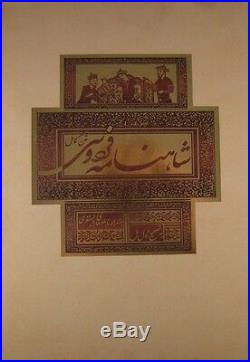
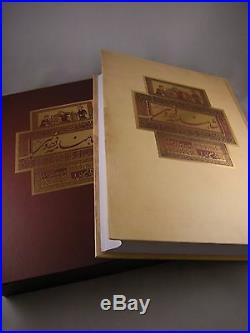
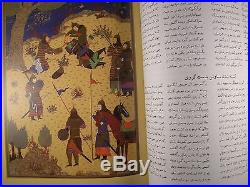
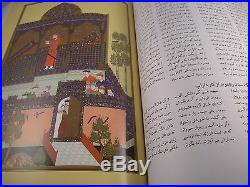
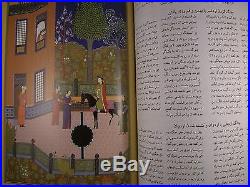
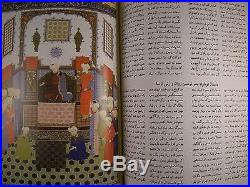
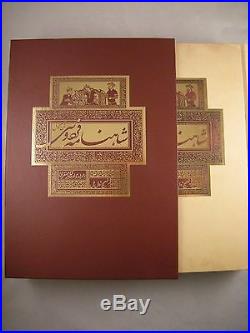

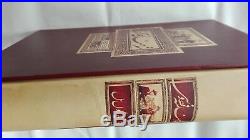
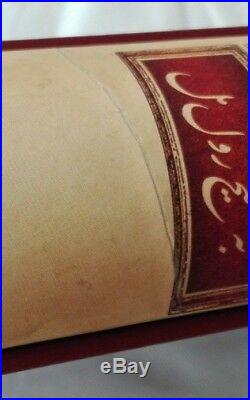



Poem Book Persian Farsi Poet. FARSI ONLY / NO TRANSLATION.
The Shahnameh, also transliterated as Shahnama ("The Book of Kings"), is a long epic poem written by the Persian poet Ferdowsi between c. 977 and 1010 CE and is the national epic of Greater Iran. Consisting of some 50,000 "distichs" or couplets (2-line verses), the Shahnameh is the world's longest epic poem written by a single poet. It tells mainly the mythical and to some extent the historical past of the Persian Empire from the creation of the world until the Islamic conquest of Persia in the 7th century.
Today Iran, Azerbaijan, Afghanistan and the greater region influenced by the Persian culture (such as Georgia, Armenia, Turkey and Dagestan) celebrate this national epic. The work is of central importance in Persian culture, regarded as a literary masterpiece, and definitive of the ethno-national cultural identity of modern-day Iran, Afghanistan and Tajikistan.
It is also important to the contemporary adherents of Zoroastrianism, in that it traces the historical links between the beginnings of the religion with the death of the last Sassanid ruler of Persia during the Muslim conquest and an end to the Zoroastrian influence in Iran. Ferdowsi started writing the Shahnameh in 977 A. D and completed it on 8 March 1010. The Shahnameh is a monument of poetry and historiography, being mainly the poetical recast of what Ferdowsi, his contemporaries, and his predecessors regarded as the account of Iran's ancient history. Many such accounts already existed in prose, an example being the Abu-Mansuri Shahnameh.
A small portion of Ferdowsi's work, in passages scattered throughout the Shahnameh, is entirely of his own conception. The Shahnameh is an epic poem of over 50, 000 couplets, written in early Modern Persian.
It is based mainly on a prose work of the same name compiled in Ferdowsi's earlier life in his native Tus. This prose Shahnameh was in turn and for the most part the translation of a Pahlavi (Middle Persian) work, known as the ("Book of Kings"), a late Sassanid compilation of the history of the kings and heroes of Persia from mythical times down to the reign of Khosrau II (590â628). Contained historical information on the later Sassanid period, but it does not appear to have drawn on any historical sources for the earlier Sassanid period (3rd to 4th centuries). Ferdowsi added material continuing the story to the overthrow of the Sassanids by the Arabs in the middle of the 7th century. The first to undertake the versification of the Pahlavi chronicle was Abu-Mansur Daqiqi, a contemporary of Ferdowsi, poet at the court of the Samanids, who came to a violent end after completing only 1, 000 verses. These verses, which deal with the rise of the prophet Zoroaster, were afterward incorporated by Ferdowsi, with acknowledgment, in his own poem. The style of the Shahnameh shows characteristics of both written and oral literature.Some claim that Ferdowsi also used Zoroastrian nasks, such as the now-lost Chihrdad, as sources as well. Many other Pahlavi sources were used in composing the epic, prominent being which was originally written during the late Sassanid era and gave accounts of how Ardashir I came to power which, because of its historical proximity, is thought to be highly accurate. Besides, the text is written in the late Middle Persian, which was the immediate ancestor of Modern Persian. Hence, a great portion of the historical chronicles given in Shahnameh are based on this epic and there are in fact various phrases and words which can be matched between these two sources according to Zabihollah Safa.
According to one account of the sources, a Persian named Dehqan in the court of King Anushehrawan Dadgar had composed a voluminous book in prose form, known as Khoday Nameh. After the fall of the Iranian Empire, Khoday Nameh came into the possession of King Yaqub Lais and then the Samani king Nuh ordered the poet Daqiqi to complete it, but Daqiqi was killed by his slave.Ferdowsi obtained the book through a friend. The Shahnameh provides a poetic account of the prehistory and history of Iran, beginning with the creation of the world and the introduction of the arts of civilization (fire, cooking, metallurgy, law), and ending with the Islamic Conquest of Persia. The work is not precisely chronological, but there is a general movement through time. Some of the characters live for hundreds of years but most have normal life spans.
There are many who come and go, as well as heroes and villains, who also come and go. The only lasting images are those of Greater Persia itself, and of a succession of sunrises and sunsets, no two ever exactly alike, yet illustrative of the passage of time. The work is divided into three successive parts: the "mythical", "heroic", and "historical" ages. Father Time, a Saturn-like image, is a reminder of the tragedy of death and loss, yet the next sunrise comes, bringing with it hope of a new day.
In the first cycle of creation, evil is external (the devil). In the second cycle, we see the beginnings of family hatred, bad behavior, and evil permeating human nature.
Shah Fereydoon's two eldest sons feel greed and envy toward their innocent younger brother and, thinking their father favors him, they murder him. The murdered prince's son avenges the murder, and all are immersed in the cycle of murder and revenge, blood and more blood. In the third cycle, we encounter a series of flawed shahs.
There is a Phaedra-like story of Shah Kay , his wife Soudabeh, and her passion for and rejection by her stepson, Seyavash. It is only in the characterizations of the work's many figures, both male and female, that Zoroaster's original view of the human condition comes through. Zoroaster emphasized human free will.
All of Ferdowsi's characters are complex; none is an archetype or a puppet. [clarification needed] The best characters have flaws, and the worst have moments of humanity. Traditional historiography in Iran has claimed that Ferdowsi was grieved by the fall of the Sassanid Empire and its subsequent rule by "Arabs" and "Turks". The Shahnameh, the argument goes, is largely his effort to preserve the memory of Persia's golden days and transmit it to a new generation so that they could learn and try to build a better world.
Although most scholars have contended that Ferdowsi's main concern was the preservation of the pre-Islamic legacy of myth and history, a number of authors have formally challenged this view. Please note that only one Iranian (pars) book per your selection will be supplied. All images are for illustration purposes only. The item "Persian Complete Shahname Ferdowsi & Paintings Farsi Book B2346" is in sale since Sunday, July 30, 2017. This item is in the category "Books\Fiction & Literature".
The seller is "parspay" and is located in -. This item can be shipped worldwide.
- Subject: Poetry
- Language: Farsi / Persian
- Format: Hardcover
- Special Attributes: Persian
